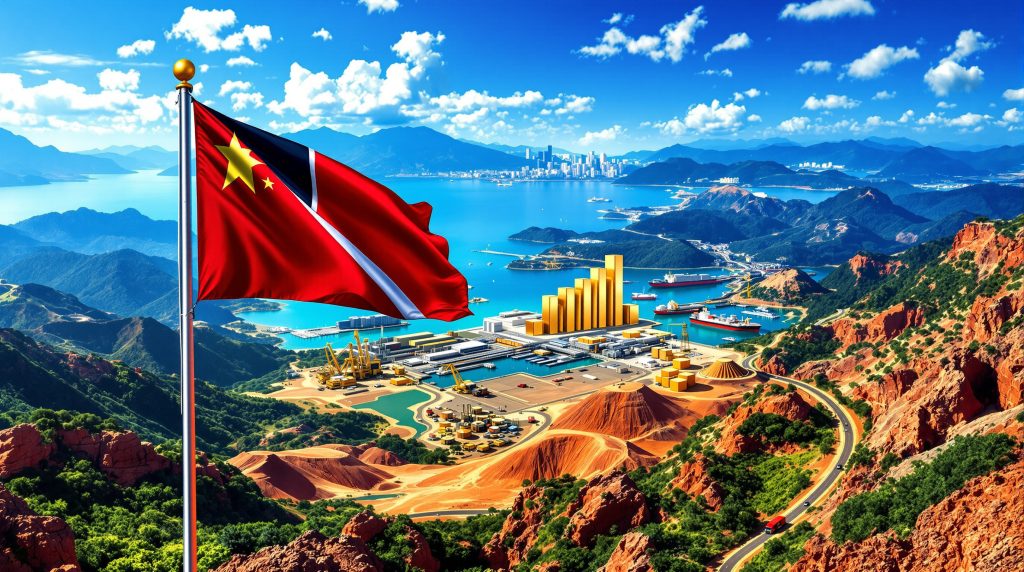Global Copper Supply Dynamics Drive Pacific Rim Investment Focus
Mining investment patterns across the Pacific Rim reflect a fundamental shift in global copper demand trends. Traditional copper-producing regions face declining ore grades and increasing operational complexity, while emerging markets present opportunities for large-scale development aligned with structural demand growth. This transformation creates strategic windows for international partnerships targeting high-grade porphyry systems in politically stable jurisdictions.
Papua New Guinea copper venture opportunities represent a convergence of geological advantages, infrastructure development, and proximity to the world's largest copper-consuming markets. Furthermore, the region's untapped resource potential, combined with established export capabilities, positions it as a critical component of future copper supply chains serving Asia-Pacific industrial growth and global decarbonisation initiatives.
Strategic Geographic Advantages in Asia-Pacific Copper Markets
Proximity Benefits for Asian Supply Chains
Papua New Guinea's strategic location provides significant logistical advantages for copper concentrate shipments to major Asian refineries. The region offers 2-4 week shipping advantages compared to Atlantic-based suppliers serving Chinese, Japanese, and South Korean markets. These nations collectively account for approximately 45-50% of global refined copper consumption, creating substantial demand pull for Pacific Rim copper production.
The established port infrastructure at key PNG locations enables efficient bulk commodity exports. In addition, existing facilities are capable of handling large-scale copper concentrate shipments. This infrastructure foundation reduces capital requirements for new mining ventures compared to greenfield locations requiring complete logistics development.
Resource Endowment and Quality Characteristics
Papua New Guinea's copper deposits occur primarily in porphyry systems typical of Pacific Rim geology, featuring multi-commodity potential with copper-gold and copper-molybdenum associations. These geological formations provide resource diversification benefits through metal credits that improve overall project economics.
The region's porphyry deposits operate within 0.3-0.4% copper equivalent grades, aligning with global industry standards for large-scale development. However, the multi-commodity nature of these deposits often generates superior economics through precious metal and molybdenum byproduct revenues.
International Partnership Structures for Large-Scale Development
Capital Allocation Models in PNG Mining Ventures
Recent developments indicate major international mining companies are structuring PNG copper investment opportunities as substantial capital commitments. African Rainbow Minerals Chairman Patrice Motsepe indicated potential Papua New Guinea copper venture investments requiring $4-5 billion in development capital, reflecting world-class project scales typical of top-tier global operations.
ARM's financial position supports such large-scale commitments, with ZAR13 billion (US$756.2 million) in cash plus facilities for a further ZAR7 billion available for Australian and Papua New Guinea copper developments. This capital availability demonstrates institutional confidence in Pacific Rim copper investment opportunities.
Joint Venture Framework Analysis
International joint venture models in PNG typically structure capital allocation through several approaches:
50/50 Joint Ventures:
- Shared capital expenditure and operating expense responsibilities
- Balanced risk distribution between partners
- Rotating management structures based on operational expertise
Majority-Minority Stakes:
- Lead partners typically fund 60-80% of development costs
- Risk allocation weighted toward majority stakeholder
- Operational control maintained by experienced operator
Strategic Alliances:
- Phased investment commitments tied to development milestones
- Stage-gate risk management through feasibility phases
- Consortium governance structures for major decisions
Investment Scale Requirements for World-Class Operations
Capital Threshold Analysis
Projects requiring $4-5 billion in development capital typically target annual production exceeding 200,000 tonnes of copper equivalent, positioning them among the world's top 20 copper operations.
This investment magnitude reflects the comprehensive infrastructure requirements for remote PNG copper development, including processing facilities, transportation networks, power generation, and community infrastructure. Consequently, the scale also indicates target production levels necessary to generate acceptable returns on multi-billion dollar capital commitments.
Financing Structure Considerations
PNG copper projects at this scale typically employ debt-to-equity ratios ranging from 60:40 to 70:30, depending on resource quality, infrastructure requirements, and off-take agreement structures. Export credit agencies often participate in project financing for major international ventures, providing long-term debt facilities supported by government backing.
Key Financing Components:
- Senior debt facilities backed by off-take agreements
- Equity commitments from joint venture partners
- Export credit agency participation for international projects
- Working capital facilities for operational requirements
Major PNG Copper Assets Under Development
Tier-1 Resource Opportunities
Papua New Guinea hosts several advanced-stage copper deposits with world-class resource potential:
Yandera Project:
- Large-scale porphyry system with substantial resource base
- Copper-gold mineralisation typical of PNG geology
- Advanced feasibility study stage with infrastructure planning
Wafi-Golpu Complex:
- High-grade copper-gold porphyry system
- Advanced permitting and community engagement progress
- Significant contained metal content in measured resources
Frieda River:
- Large copper resource base in measured and indicated categories
- Multi-phase development potential
- Strategic location for infrastructure development
Comparative Investment Assessment
| Investment Factor | PNG Advantages | Risk Considerations |
|---|---|---|
| Resource Quality | High-grade porphyry systems | Geological complexity in remote areas |
| Political Environment | Democratic governance framework | Community relations management |
| Infrastructure Access | Established coastal export facilities | Remote inland logistics challenges |
| Regulatory Framework | Mining-friendly policies | Environmental compliance requirements |
How Does Decarbonisation Drive Copper Investment Demand?
Electric Vehicle Supply Chain Positioning
The global transition to electric vehicles creates substantial structural copper demand growth. Electric vehicle powertrains require 50-90 kg of copper per vehicle depending on motor specifications and battery management systems. This copper intensity far exceeds traditional internal combustion vehicles, creating sustained demand growth aligned with EV adoption curves.
Decarbonisation and copper demand factors position Papua New Guinea copper venture development strategically within these long-term trends. As ARM Chairman Motsepe indicated, PNG investment represents a strategy connected to global decarbonisation trends and rising demand for critical minerals, positioning the region as a strategic supplier for EV supply chains.
Green Energy Infrastructure Requirements
Renewable energy infrastructure development drives additional copper demand through:
- Wind installations: High copper content in generators and transmission systems
- Solar systems: Copper wiring and power conditioning equipment
- Grid modernisation: Enhanced transmission capacity for renewable integration
- Energy storage: Battery systems requiring copper connectivity
These applications create copper demand intensity significantly exceeding traditional energy infrastructure, supporting long-term price fundamentals for PNG copper projects.
Community Engagement and Social Licence Development
Stakeholder Partnership Models
Successful Papua New Guinea copper venture operations require comprehensive community engagement frameworks addressing landowner rights, environmental stewardship, and economic benefit-sharing. Traditional landowner benefit arrangements typically include 2-5% of project revenues distributed through community development programmes and direct payments.
Critical Success Factors:
- Early engagement: Community consultation during exploration phases
- Transparent communication: Regular project updates and environmental monitoring
- Economic participation: Local employment and contracting opportunities
- Cultural respect: Recognition of traditional land use and cultural practices
- Environmental protection: Rigorous impact mitigation and restoration programmes
Technical Excellence Requirements
PNG copper project success depends on operational excellence across multiple technical domains:
Processing Technology Selection:
- Flotation circuit design optimised for PNG ore characteristics
- Multi-commodity recovery systems for copper-gold deposits
- Environmental impact minimisation through advanced processing
Logistics Optimisation:
- Transportation solutions for remote site locations
- Port facility integration for concentrate export
- Supply chain efficiency for operational materials
Investment Evaluation Framework for PNG Opportunities
Due Diligence Process
Investors evaluating Papua New Guinea copper venture opportunities should employ systematic assessment protocols:
-
Resource Validation
- Independent geological assessment and reserve certification
- Metallurgical testing for processing optimisation
- Resource expansion potential evaluation
-
Regulatory Compliance Assessment
- Mining lease status and tenure security
- Environmental permitting progress and requirements
- Government policy stability and fiscal framework
-
Infrastructure Evaluation
- Transportation access and development requirements
- Power generation and transmission availability
- Water access and treatment capabilities
-
Community Relations Review
- Social licence status and stakeholder engagement quality
- Benefit-sharing agreement negotiations and terms
- Cultural heritage and environmental impact assessments
-
Financial Modelling
- Net present value analysis under various copper price scenarios
- Capital expenditure phasing and financing requirements
- Operating cost benchmarking against global operations
Risk-Adjusted Return Analysis
PNG copper investments require sophisticated financial modelling addressing multiple scenario outcomes:
Base Case Scenarios: $3.50-4.00/lb copper price assumptions reflecting long-term supply-demand fundamentals and cost curve positioning.
Upside Potential: $5.00+/lb copper pricing in supply-constrained markets driven by accelerated decarbonisation and infrastructure development.
Downside Protection: Break-even analysis at $2.80-3.20/lb copper, requiring operational excellence and cost optimisation.
Global Copper Market Dynamics and Investment Timing
Supply-Demand Fundamental Analysis
Current global copper markets exhibit structural deficits ranging from 400,000-600,000 tonnes annually, with deficit expansion projected to 2-3 million tonnes by 2030 driven by electrification and renewable energy infrastructure development.
Papua New Guinea's copper development potential could contribute 300,000-500,000 tonnes annually to global supply, representing meaningful deficit closure capability. This supply contribution positions PNG projects as strategically important for global market balance.
Strategic Investment Windows
PNG copper venture investment timing considerations include:
Pre-Development Phase:
- Highest risk exposure through exploration and feasibility
- Greatest return potential for successful project development
- Opportunity for strategic asset acquisition at favourable valuations
Construction Phase Partnerships:
- Moderate risk profile with substantial return potential
- Capital deployment during infrastructure development
- Joint venture participation with established operators
Production-Stage Acquisitions:
- Lower risk exposure with steady cash flow generation
- Asset acquisition at full operational valuations
- Portfolio diversification through producing assets
Long-Term Strategic Outlook for PNG Copper Development
Investment Catalyst Timeline
Papua New Guinea's copper sector development faces several key catalysts through 2025-2030:
- Feasibility Study Completion: Major projects advancing through technical and economic assessment phases
- Infrastructure Commitments: Government and private sector coordination on transportation and power development
- Community Agreements: Finalisation of benefit-sharing frameworks and social licence arrangements
- Copper Price Stability: Sustained pricing above $4.00/lb supporting project economics and investment decisions
Market Positioning Advantages
PNG's copper sector offers compelling investment characteristics for companies seeking exposure to Asian demand growth and global decarbonisation trends. The combination of world-class geological resources, improving infrastructure capabilities, and strategic geographic positioning creates favourable conditions for large-scale copper development partnerships.
The region's porphyry copper systems provide long-life, large-scale production potential aligned with institutional investor requirements for sustainable cash flow generation. Moreover, multi-commodity characteristics offer additional value through precious metal credits and portfolio diversification benefits.
Partnership Development Framework
Successful Papua New Guinea copper venture operations require sophisticated partnership structures addressing technical expertise, financial capacity, and operational excellence. International mining companies increasingly recognise PNG's strategic importance for Pacific Rim copper supply chains serving the world's largest consuming markets.
For instance, mining infrastructure optimisation becomes critical when developing remote PNG assets. Furthermore, ARM considers Papua New Guinea copper ventures as part of broader regional development strategies that leverage established mining expertise and financial capabilities.
Investment decisions should consider individual risk tolerance, portfolio objectives, and comprehensive due diligence. Papua New Guinea copper venture opportunities involve significant capital requirements, technical complexity, and regulatory considerations that may not be suitable for all investors.
Looking to Capitalise on Papua New Guinea's Copper Investment Surge?
Discovery Alert instantly identifies ASX-listed companies with PNG copper exposure and strategic mineral discoveries, powered by its proprietary Discovery IQ model that transforms complex geological announcements into actionable investment insights. Begin your 30-day free trial today with Discovery Alert to position yourself ahead of the market and gain immediate access to significant copper discovery alerts across the Pacific Rim.




